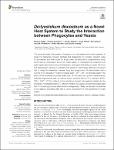Dictyostelium discoideum as a Novel Host System to Study the Interaction between Phagocytes and Yeasts
Koller, Barbara
Schramm, Christin
Siebert, Susann
Triebel, János
Deland, Eric
Pfefferkorn, Anna M.
Rickerts, Volker
Thewes, Sascha
The social amoeba Dictyostelium discoideum is a well-established model organism to study the interaction between bacteria and phagocytes. In contrast, research using D. discoideum as a host model for fungi is rare. We describe a comprehensive study, which uses D. discoideum as a host model system to investigate the interaction with apathogenic (Saccharomyces cerevisiae) and pathogenic (Candida sp.) yeast. We show that Dictyostelium can be co-cultivated with yeasts on solid media, offering a convenient test to study the interaction between fungi and phagocytes. We demonstrate that a number of D. discoideum mutants increase (atg1−, kil1−, kil2−) or decrease (atg6−) the ability of the amoebae to predate yeast cells. On the yeast side, growth characteristics, reduced phagocytosis rate, as well as known virulence factors of C. albicans (EFG1, CPH1, HGC1, ICL1) contribute to the resistance of yeast cells against predation by the amoebae. Investigating haploid C. albicans strains, we suggest using the amoebae plate test for screening purposes after random mutagenesis. Finally, we discuss the potential of our adapted amoebae plate test to use D. discoideum for risk assessment of yeast strains.
Dateien zu dieser Publikation
Keine Lizenzangabe

